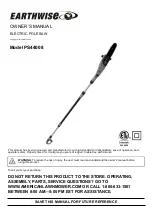
4.
Screw the scroll saw onto the workbench with
the hexagonal bolt (E) through the assembly
points (fig. 3 pos. 19) in the following sequence
(fig. 5.1):
A Fretsaw
B Work table
C Washer
D Hexagonal nut
5.
Tighten the hexagonal nut (D) first.
8. Assembly
WARNING
Danger of injury! Disconnect the mains plug on the
scroll saw before all assembly work.
9.1 Fitting / Replacing the saw blade (fig. 1, 8-11)
IMPORTANT
To avoid injuries attributed to inadvertent startup:
Before removing or replacing the saw blade, always
press “0“ and remove the mains plug from the socket.
8.1.1 Removing the saw blade without pins (op-
tional)
1.
To remove the saw blade (22) , lift the table in-
sert (26) upwards.
2.
First, release the tension by flipping the tension
lever (11) upwards. Continue reducing the ten-
sion by turning clockwise as required.
3.
Press the support (12) down lightly (see fig. 9).
4.
Then loosen the upper saw blade clamping lever
(28), followed by the lower saw blade clamping
lever (29) using the Allen key (23).
8.1.2
Inserting the saw blade without pins
(optional)
The teeth of the saw blade must always point down-
wards.
1.
First, secure the saw blade (22) in the lower saw
blade mounting (30). To secure the saw blade
(22), tighten the lower saw blade clamping screw
(29) using the Allen key (23).
2.
Press the support (12) down lightly. Fasten the
other end of the saw blade (22) in the top saw
blade holder (27) (see fig. 9).
3.
Fix the saw blade (22) with the upper blade
clamping screw (28) (see fig. 10).
4.
Tighten the saw blade (22) with the clamping le-
ver (11), by pressing it down again. Check the
tension of the saw blade (22). If the tension is
insufficient, it can be increased by turning the
lever clockwise. First release the clamping lever
(11).
5.
Put the table insert (26) back.
8.1.3 Removing the saw blade with pins
1.
To remove the saw blade (22), lift the table insert
(26) upwards.
2.
First, release the tension by flipping the tension
lever (11) upwards. Continue reducing the ten-
sion by turning clockwise as required.
3.
Press the support (12) down lightly (see fig. 9).
4.
Pull the saw blade from the upper and lower saw
blade mounting (27/30).
8.1.4 Inserting the saw blade with pins
The teeth of the saw blade must always point down-
wards.
1.
Insert one end of the saw blade (22) through the
drilled hole in the table. Insert the pins of the
saw blade (22) into the corresponding recesses
of the top and bottom saw blade holder (27/30).
2.
First insert the saw blade (22), in the lower blade
holder (30).
3.
Press the support (12) down lightly (see fig. 9).
4.
Check the position of the saw blade pins in the
saw blade mountings (27/30).
5.
Tighten the saw blade (22) with the clamping le-
ver (11), by pressing it down again. Check the
tension of the saw blade (22). If the tension is
insufficient, it can be increased by turning the
lever (11) clockwise.
6. Put the table insert (26) back.
NOTE
The left side features a storage box (9), which ena-
bles you to stow replacement saw blades and the
hexagon wrench.
8.2 Checking the saw blade tension
WARNING
Check the blade tension regularly and after in-
serting a saw blade.
Tension the saw blade after assembly by pressing
down on the tension lever (11).
If the blade tension is too low or too high, proceed as
follows:
•
Fold the tension lever (11) upwards.
•
Turn the tension lever (11) clockwise to increase the
tension and anti-clockwise to reduce it.
•
Press the tension lever down again to engage the
setting.
If the tension is correct, the saw blade should pro-
duce a light tone when it is plucked, like a string.
8.3 Calibrating the angle scale (fig. 12, 12.1)
IMPORTANT
Check the adjustment of the angular scale before you
start working with the unit.
www.scheppach.com
26
| GB
Summary of Contents for DECO-XLS
Page 142: ...www scheppach com 142 ...
Page 143: ...www scheppach com 143 ...
















































